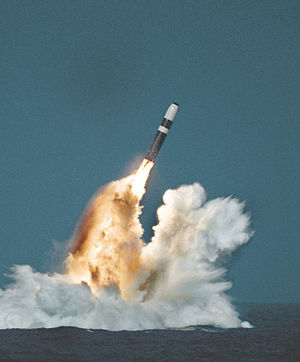三叉戟II型彈道導彈
外觀
| UGM-133A三叉戟II型彈道導彈 | |
|---|---|
 | |
| 類型 | 潛射彈道導彈 |
| 原產地 | |
| 服役記錄 | |
| 服役期間 | 1990年 |
| 使用方 | 美國海軍 英國海軍 |
| 生產歷史 | |
| 生產商 | 洛歇·馬丁 |
| 單位成本 | $3732萬美元 (2014年)[1] |
| 生產日期 | 1983年 |
| 基本規格 | |
| 重量 | 130,000磅(59,000公斤)[1] |
| 長度 | 44英尺6.6英寸(13.579米) |
| 直徑 | 6英尺11英寸(2.11米)(第一級)[1] |
| 彈頭 | 8至12枚W88型或W76型氫彈分導式多彈頭[2][3] |
| 爆炸當量 | - 每枚W88型彈頭47.5萬噸當量 - 12枚W88型彈頭合共570萬噸當量 |
| 發動機 | 3具固體火箭發動機 [4] |
| 推進劑 | 硝酸酯, 聚乙二醇[5] |
| 作戰範圍 | 超過12,000公里(7,500英里)[6][7](具體作戰範圍沒有公佈)[8] |
| 速度 | 時速約29,020公里(18,030英里),24馬赫,每秒8060米[1] (末端速度) |
| 制導系統 | MK6型導彈制導,由GPS引導定位[1][9] |
| 轉向系統 | 單具矢量推力[5] |
| 精度 | - MK6彈頭精度不明 - MK5彈頭精度約90米[7] |
| 發射平台 | 彈道導彈潛艇 |
UGM-133A三叉戟II型彈道導彈,又稱三叉戟D5是一款潛射彈道導彈(SLBM),由洛歇·馬丁公司位於加州森尼韋爾的空間系統公司研發製造,裝備美國以及英國海軍。三叉戟II型於1990年首次服役[4],是三叉戟I型的改進型號,打擊精度更高,載荷、航程也均有增加。是美國核三位一體重要的一環,也是美國核威懾重要的組成部分。三叉戟II型是具有威懾力的海基彈道導彈,也是美國在新削減戰略武器條約的談判過程中有力的籌碼。由於彈頭載荷的增大,美國軍方只需要更少的核潛艇就能達成同樣的核威懾力[10],且由於及精度很高,接近陸基彈道導彈,三叉戟II型可用於一次打擊。[11][12][13]
戰備
[編輯]目前搭載三叉戟II型的潛艇有14艘美國海軍的俄亥俄級核潛艇以及4艘英國海軍前衛級核潛艇,每艘俄亥俄級能搭載24枚,前衛級能搭載16枚(因美俄簽署了新削減戰略武器條約,俄亥俄級把搭載數量減少到20枚)。1989年設計完成後,已經有161次成功的試射。[14]最近一次試射由俄亥俄級內布拉斯加號於2018年3月執行。[15]另外大約有少於10次的發射失敗[16],上一次發射失敗是2016年6月份,英國皇家海軍前衛級復仇號潛艇_(S31)發射三叉戟II型失敗[17]。2002年美國海軍公佈延壽計劃, 三叉戟II型預計將服役至2040年。[18]
參考資料
[編輯]- ^ 1.0 1.1 1.2 1.3 1.4 Parsch, Andreas. Trident D-5. Encyclopedia Astronautica. [11 June 2014]. (原始內容存檔於2018-09-24).
- ^ The W88 Warhead, Intermediate yield strategic SLBM MIRV warhead. [12 June 2014].
- ^ The W76 Warhead, Intermediate Yield Strategic SLBM MIRV Warhead. [12 June 2014].
- ^ 4.0 4.1 Parsch, Andreas. UGM-133. Directory of U.S. Military Rockets and Missiles. [11 June 2014]. (原始內容存檔於2019-05-14).
- ^ 5.0 5.1 History Facts 2. [21 June 2014]. (原始內容存檔於2021-04-28).
- ^ Fact file: Trident missile. 23 September 2009 [29 March 2018]. (原始內容存檔於2017-09-29) –透過news.bbc.co.uk.
- ^ 7.0 7.1 Trident D-5 - Missile Threat. csis.org. [29 March 2018]. (原始內容存檔於2016-11-04).
- ^ DEPARTMENT OF DEFENSE APPROPRIATIONS ACT, 1996 (Senate – August 11, 1995). [13 June 2014]. (原始內容存檔於2016-04-17).
- ^ Lockheed Martin UGM-133 Trident II. www.designation-systems.net. [29 March 2018]. (原始內容存檔於2019-05-14).
- ^ Trident II (D-5) Sea-Launched Ballistic Missile UGM 133A (Trident II Missile) (PDF). [21 June 2014]. (原始內容 (PDF)存檔於2014-01-12).
- ^ Lieber, Keir A.; Press, Daryl G. U.S. Nuclear Primacy and the Future of the Chinese Deterrent (PDF). China Security: 77. 2007 [2018-09-25]. (原始內容存檔 (PDF)於2017-05-16).
During the past 15 years, the United States has done so much to upgrade its first strike capabilities – most notably by deploying Trident II D-5 missiles throughout the entire ballistic missile submarine (SSBN) fleet, placing high-yield W88 warheads on many of those missiles, and deploying stealthy B-2 bombers – that today a first strike could succeed even if the performance of key U.S. weapon systems fell far short of their expected accuracy, reliability, or both.
參數|journal=與模板{{cite web}}不匹配(建議改用{{cite journal}}或|website=) (幫助);|volume=被忽略 (幫助) - ^ Cimbala, Stephen J. Military persuasion: Deterrence and provocation in crisis and war. Penn State Press: 85–6. 2010 [29 January 2016]. (原始內容存檔於2018-09-26).
By the end of the 1980s, however, the submarine-launched ballistic missile had turned another page. The accuracy of the Trident II (D-5) SLBM, planned as the replacement for the Trident I with Trident II deployments beginning in 1989, was comparable to that of the MX/Peacekeeper ICBM, the most accurate land-based missile in the U.S. strategic arsenal. Owing to its improved accuracy and larger payload compared to its SLBM predecessors, Trident II would be able to attack hardened targets in the Soviet Union that were not previously vulnerable to sea-launched ballistic missiles. Although U.S. planners might assume that these strikes against hardened targets in the Soviet Union would be retaliatory attacks, a Soviet net-assessment of U.S. first-strike capabilities would have to include the improved sea-based missiles.
- ^ Stellan Vinthagen. Tackling Trident. Irene Publishing: 41. 2012 [29 November 2017]. (原始內容存檔於2018-09-26).
Although it is acurate enough for a 'first strike' weapon, successive governments have been adamant that the purpose of the current Trident system is as a 'deterrent' against nuclear or similarly cataclysmic attack on Britain. The Trident 'mission' is outlined by the Ministry of Defense: 'In a posture known as Continuous At Sea Defence (CASD), one submarine, armed with up to 16 Trident missiles and up to 48 warheads, is always on deterrent patrol 24 hours a day, 365 days a year' (MoD, 2006).
- ^ Successful Trident II D5 Missile Flight Test Supports Navy Submarine Certification for Strategic Patrol. Lockheed Martin. 13 September 2016 [26 January 2017]. (原始內容存檔於2017-01-26).
- ^ US Sub Test Fires 2 Ballistic Missiles in Pacific Ocean. [2018-09-25]. (原始內容存檔於2018-07-19).
- ^ McCann, Kate; Dominiczak, Peter; Swinford, Steven. US Trident failure claims contradict Michael Fallon. The Daily Telegraph. 23 January 2017 [26 January 2017]. (原始內容存檔於2017-01-25).
- ^ How serious was the Trident missile test failure?. UK Defence Journal. 22 January 2017 [24 January 2017]. (原始內容存檔於2019-09-19).
- ^ U.S. Nuclear Modernization Programs. Arms Control Association. August 2016 [6 September 2016]. (原始內容存檔於2018-07-16).
